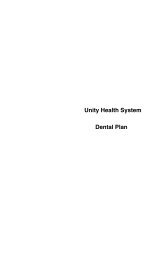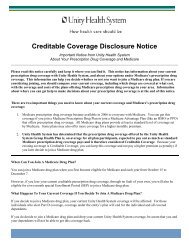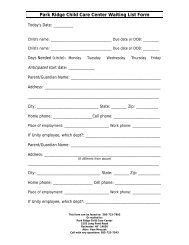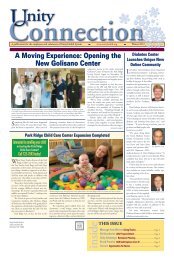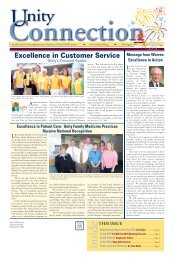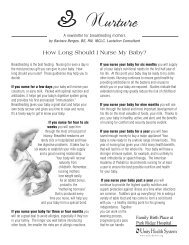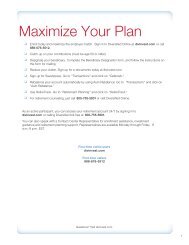Practical Review of Post Traumatic Stress Disorder (PTSD) and the ...
Practical Review of Post Traumatic Stress Disorder (PTSD) and the ...
Practical Review of Post Traumatic Stress Disorder (PTSD) and the ...
Create successful ePaper yourself
Turn your PDF publications into a flip-book with our unique Google optimized e-Paper software.
The Returning Veteran<br />
<strong>and</strong><br />
A <strong>Practical</strong> <strong>Review</strong> <strong>of</strong><br />
<strong>Post</strong>traumatic <strong>Stress</strong> <strong>Disorder</strong><br />
Mat<strong>the</strong>w J. Barry, DO<br />
Lead Psychiatrist<br />
Rochester VA Outpatient Clinic<br />
19 JAN 2011
Agenda<br />
• The Returning Veteran<br />
– The experience<br />
– Treatment services<br />
– Transition from DoD to VA health care<br />
• <strong>Post</strong>traumatic <strong>Stress</strong> <strong>Disorder</strong><br />
– Neurobiology<br />
– Treatment<br />
• Therapy<br />
• Medications<br />
• Questions
Components <strong>of</strong> <strong>the</strong> US Military<br />
• Army<br />
• Navy<br />
• Air Force<br />
• Marine Corps<br />
• Coast Guard
Classifications <strong>of</strong> <strong>the</strong> US Military<br />
• Active Duty<br />
• Reserve Forces<br />
• National Guard<br />
• Individual Ready Reserve (IRR)
Active Component<br />
• Federal Service<br />
• Currently 1,454,515<br />
• Deployments NOW no longer than 12 months in<br />
most cases (may work 24/7)<br />
• Deployed Worldwide<br />
– CONUS<br />
– OCONUS in Afghanistan, Germany, Japan, Korea, Africa…
Reserve Component<br />
• Federal Service<br />
• Part‐time Job<br />
• Currently 355,000<br />
• Monthly Battle Assembly<br />
• Transitions from Reserve Status to Active Duty<br />
• Deployed During Times <strong>of</strong> War, Peace‐keeping <strong>and</strong><br />
Federal Need
National Guard Component<br />
• State Service<br />
• Part‐time Job<br />
• Currently 459,300<br />
• Deployed During Times <strong>of</strong> War, Peace‐keeping <strong>and</strong><br />
Disaster Relief
Troops<br />
Component Military Enlisted Officer Female Civilian<br />
Army 569,000 456,651 88,093 73,902 243,172<br />
Navy 331,768 276,276 51,093 50,008 182,845<br />
Marine 201,031 180,443 20,588 12,290<br />
Air Force 329,980 261,193 64,370 64,137 154,032<br />
Coast Guard 42,583<br />
Reserves &<br />
National<br />
Guard<br />
847,000
Numbers ‐ Army<br />
1. Total number <strong>of</strong> Soldiers in Afghanistan<br />
2. Percent <strong>of</strong> <strong>the</strong>se Soldiers on psychiatric meds<br />
3. Number <strong>of</strong> <strong>the</strong>se Soldiers who will have<br />
symptoms, or actual diagnosis <strong>of</strong> <strong>PTSD</strong>
Mental Health Status <strong>of</strong> Soldiers<br />
<strong>and</strong> Marines<br />
• Data relatively consistent from OIF I to OIF 05‐07.<br />
• Findings from <strong>the</strong> WRAIR L<strong>and</strong> Combat Study<br />
indicate that <strong>the</strong>se rates may increase fur<strong>the</strong>r at 6<br />
<strong>and</strong> 12 months post‐deployment<br />
Percent Screening Positive<br />
35<br />
30<br />
25<br />
20<br />
15<br />
10<br />
5<br />
0<br />
OIF I Soldiers<br />
OIF 04-06 Soldiers<br />
OIF 05-07 Soldiers OIF 05-07 Marines<br />
16<br />
20 20<br />
17<br />
17<br />
14 14 15<br />
Acute <strong>Stress</strong> (<strong>PTSD</strong> scale)<br />
Any Mental Health Problem<br />
(anxiety, depression, or acute<br />
stress)
Soldier Multiple Deployments<br />
• Findings from <strong>the</strong> WRAIR L<strong>and</strong> Combat Study indicate<br />
that Soldiers’ mental health status does not “re‐set”<br />
prior to deploying to Iraq a second time.<br />
• Soldiers deployed to Iraq more than once were more<br />
likely to screen positive for a mental health problem<br />
than first‐time deployers.<br />
Percent Screening Positive<br />
50<br />
40<br />
30<br />
20<br />
10<br />
15<br />
OIF 05-07 First time Deployers<br />
OIF 05-07 Multiple Deployers<br />
24 27<br />
17<br />
0<br />
Acute <strong>Stress</strong> (<strong>PTSD</strong> scale)<br />
Any Mental Health Problem
Stigma Toward Mental Health Care<br />
• Stigma among Soldiers towards using behavioral health care is relatively<br />
stable over time.<br />
Stigma prevents Soldiers<br />
from Using Mental Health<br />
13% <strong>of</strong> ALL Soldiers <strong>and</strong> 7% <strong>of</strong><br />
ALL Marines reported being<br />
interested in receiving help for<br />
a stress, emotional, alcohol or<br />
family problem.<br />
Only 42% <strong>of</strong> Soldiers who<br />
screened positive for a mental<br />
health problem sought help<br />
from a behavioral health<br />
provider, primary care provider<br />
or chaplain.<br />
My unit leadership might<br />
treat me differently<br />
I would be seen as<br />
weak<br />
Members <strong>of</strong> my unit<br />
might have less<br />
confidence in me<br />
It would harm my<br />
career<br />
38<br />
36<br />
31<br />
35<br />
36<br />
57<br />
53<br />
59<br />
48<br />
54<br />
48<br />
55<br />
48<br />
54<br />
54<br />
47<br />
OIF I<br />
Soldiers<br />
0 20 40 60 80 100<br />
Percent Agree or Strongly Agree<br />
OIF 04-06<br />
Soldiers<br />
OIF 05-07<br />
Soldiers<br />
OIF 05-07<br />
Marines
Relationship / Family Problems<br />
• About 15% <strong>of</strong> married Soldiers reported serious relationship concerns.<br />
• 2% reported engaging in severe spouse abuse within <strong>the</strong> past month.<br />
• Of 1,883 Soldiers who deployed, 26% reported that <strong>the</strong> process <strong>of</strong> reunion/ reintegration<br />
with <strong>the</strong>ir family was very stressful.<br />
• Most children are adjusting well. However, 29% <strong>of</strong> Soldiers report <strong>the</strong>ir children are<br />
having significant behavioral problems, including fighting, depression, <strong>and</strong> threats <strong>of</strong> selfharm<br />
20<br />
Percent Reporting "Yes"<br />
15<br />
10<br />
5<br />
9.7<br />
9.1<br />
3.9<br />
2.0<br />
0<br />
Infidelity a Problem<br />
Planning<br />
Divorce/Separation<br />
Spouse Abuse -<br />
Moderate<br />
Spouse Abuse -<br />
Severe
Treatment in Theater<br />
<strong>and</strong> Home Station<br />
• Combat <strong>and</strong> Operational <strong>Stress</strong> Control<br />
– Over 200 mental health providers in Afghanistan<br />
• Prevention<br />
• Treatment<br />
• Restoration<br />
• Medication<br />
– Clarity <strong>of</strong> use <strong>of</strong> psychiatric medications for deployment<br />
• Health Affairs Policy Nov 06<br />
• Army guidelines Apr 07<br />
– SSRIs<br />
• Psycho<strong>the</strong>rapy<br />
– Cognitive‐behavioral <strong>the</strong>rapy (CBT)<br />
– Exposure <strong>the</strong>rapy<br />
• Resiliency Training<br />
• Suicide Prevention<br />
• Air Evacuation <strong>and</strong> Disposition from <strong>the</strong> military
Current Challenges:<br />
Typical 12‐month Redeployment Cycle<br />
JAN FEB MAR APR MAY JUN JUL AUG SEP OCT NOV DEC<br />
Return/<br />
screenings<br />
Block<br />
Leave<br />
Retrain<br />
Re-Screen<br />
JRTC/NTC<br />
Block<br />
Leave<br />
Therapy
Operation Enduring Freedom/<br />
Operation Iraqi Freedom<br />
• Numerous stressors<br />
– Multiple <strong>and</strong> extended deployments<br />
– Battlefield stressors<br />
• IEDs, bodies, killing<br />
– Medical<br />
• Severely wounded Soldiers, injured children, detainees<br />
• More <strong>of</strong>ten you go, higher chances <strong>of</strong> difficulty<br />
• Unit cohesion <strong>and</strong> morale are key to resilience<br />
• Stigma is high in military population<br />
• Increasing isolation <strong>of</strong> career Soldiers from society<br />
• Difficult to provide evidence based care due to tempo
Transition
VA Services<br />
(just a few <strong>of</strong> <strong>the</strong>m!)<br />
• Behavioral health clinic,<br />
including <strong>PTSD</strong> specialty<br />
clinic<br />
• Vet Center<br />
• Veterans Outreach<br />
Center<br />
• Vocational<br />
rehabilitation<br />
• Primary / specialty<br />
health care<br />
• Inpatient, Residential,<br />
Domiciliary Services<br />
• Intensive Case<br />
Management<br />
• Veterans Court<br />
• GI Bill<br />
• Family support<br />
• Substance abuse<br />
services
What Can You Do At Your Clinic<br />
• Engage <strong>the</strong> patient:<br />
– 6 questions to ask military veterans (Current Psychiatry, Sep 2008)<br />
1) Did you experience traumatic events while deployed<br />
2) What was your job in <strong>the</strong> military<br />
3) Were you stop‐lossed<br />
4) Did you receive mental health care downrange<br />
5) How did you exit <strong>the</strong> military<br />
6) Have you enrolled in <strong>the</strong> VA
What Can You Do At Your Clinic<br />
• Encourage Veterans to get VA services<br />
– Veterans Service Center, 585‐463‐2687<br />
– Rochester Outpatient Clinic, 585‐463‐2668<br />
– Vet Center, 585‐232‐5040<br />
– Veteran Outreach Center, 585‐546‐1081<br />
– National Health Care line, 1‐877‐222‐VETS (8387)<br />
– Crisis line, 1‐800‐273‐8255<br />
– http://t2health.org/mobile‐apps<br />
– Afterdeployment.org<br />
– www.ptsd.va.gov<br />
– www.dcoe.health.mil
What Can You Do At Your Clinic<br />
• Improve your knowledge base:<br />
– National Center for <strong>PTSD</strong><br />
• www.ptsd.va.gov<br />
– Center for Deployment Psychology<br />
• www.dcoe.health.mil<br />
– Veterans Mental Health Training Initiative<br />
• NASW, 4/27/12<br />
• www.naswnys.org/veterans_yr2.html
Agenda<br />
• The Returning Veteran<br />
– The experience<br />
– Treatment services<br />
– Transition from DoD to VA health care<br />
• <strong>Post</strong>traumatic <strong>Stress</strong> <strong>Disorder</strong><br />
– Neurobiology<br />
– Treatment<br />
• Therapy<br />
• Medications<br />
• Questions
Consistent Findings in <strong>the</strong> Literature<br />
• Trauma exposure is extremely common<br />
• <strong>PTSD</strong> is relatively rare<br />
• Many people recover from <strong>PTSD</strong>, but a<br />
minority develop chronic <strong>and</strong> persistent<br />
symptoms<br />
• O<strong>the</strong>r psychiatric disorders may develop or<br />
co‐occur with <strong>PTSD</strong>
Numbers ‐ VA<br />
1. Number <strong>of</strong> Veterans who served in ei<strong>the</strong>r<br />
Iraq or Afghanistan<br />
2. OEF/OIF Veterans eligible for VA healthcare<br />
3. OEF/OIF eligible Veterans getting healthcare<br />
at <strong>the</strong> VA<br />
3. OEF/OIF Veterans diagnosed with <strong>PTSD</strong>
Neurobiology<br />
Prefrontal Cortex<br />
•“Executive function”<br />
•Cognitive response<br />
•Working memory<br />
•Attention<br />
•Carrying out tasks<br />
•Suppresses amygdala
Neurobiology<br />
Anterior Cingulate<br />
Cortex<br />
•Interprets emotional<br />
stimuli <strong>and</strong> processes<br />
responses<br />
•Gating function in<br />
modulating conditioned<br />
fear response
Neurobiology<br />
Hippocampus<br />
•Contextual provider
Neurobiology<br />
Amygdala<br />
•Emotional processor
Neurobiology
Neurobiology<br />
Norepinepherine<br />
Adaptive<br />
• Flight Response<br />
• Fear<br />
• Sympa<strong>the</strong>tic Activation<br />
• Conditioning<br />
• Consolidation<br />
Symptomatic<br />
• Hypervigilance<br />
• Autonomic Arousal<br />
• Fear<br />
• Exaggerated Startle<br />
• Flashbacks<br />
• Intrusive Memories
Neurobiology<br />
Serotonin<br />
Adaptive<br />
• Fight Response<br />
• Aggressive Retaliation<br />
• Self Defense<br />
• Rage<br />
• Attenuation <strong>of</strong> Fear<br />
Symptomatic<br />
• Aggression<br />
• Violence<br />
• Suicide Attempts<br />
• Impulsivity<br />
• Depression<br />
• Anxiety <strong>and</strong> Panic
Neurobiology<br />
Gaba<br />
Adaptive<br />
• Anxiolysis<br />
• Hormonal Modulation<br />
• Neurotransmission<br />
Modulation<br />
• Cognitive Functionality<br />
• Decreases Release <strong>of</strong> CRF<br />
Symptomatic<br />
• Anxiety<br />
• Reexperiencing<br />
• Impulsivity<br />
• Hyperarousal
CRF<br />
Hypothalamus<br />
Anterior<br />
Pituitary<br />
<strong>Post</strong>erior<br />
Pituitary<br />
Locus<br />
Coeruleus<br />
Adrenal<br />
Kidney<br />
ACTH<br />
Cortisol<br />
Norepinephrine
Neurobiology<br />
Lateral Nucleus <strong>of</strong> Amygdala<br />
++ glu ‐‐ gaba ++5HT<br />
Central Nucleus<br />
<strong>of</strong> Amygdala
“Battlemind”<br />
• In a dangerous situation you don’t want to<br />
sit around <strong>and</strong> think. You want to act<br />
immediately using your amygdala <strong>and</strong><br />
bypassing your frontal lobe.<br />
• In <strong>PTSD</strong> <strong>the</strong> brain acts like you are in a<br />
dangerous situation all <strong>the</strong> time. The<br />
amygdala is hyperactive <strong>and</strong> <strong>the</strong> frontal<br />
lobe functions poorly.
Neurobiologic Alterations in <strong>PTSD</strong><br />
• Amygdala hyperactivity<br />
• Prefrontal cortex is deficient<br />
• Neurotransmission dysfunction<br />
– Too much norepinepherine<br />
– Too little serotonin<br />
– Deficiency <strong>of</strong> gaba<br />
• <strong>Stress</strong> hormone systems<br />
• Thyroid<br />
• Immune system<br />
• Hippocampal volume loss<br />
• Anterior cingulate
Neuroimaging in <strong>PTSD</strong><br />
• Amygdala – hyperactivity, responsivity is<br />
associated with <strong>PTSD</strong> symptom<br />
severity<br />
• Frontal cortex –volume loss, responsivity<br />
is inversely associated with <strong>PTSD</strong><br />
symptom severity<br />
• Hippocampus –volume loss, decreased<br />
neuronal <strong>and</strong> functional integrity
Salient Features <strong>of</strong> <strong>PTSD</strong><br />
• Hyperresponsiveness to stimuli that are<br />
reminders <strong>of</strong> <strong>the</strong> trauma<br />
Amygdalar hyperactivity<br />
• Overgeneralization <strong>of</strong> stimuli<br />
Hippocampal dysfunction<br />
• Anger dyscontrol, failure <strong>of</strong> extinction<br />
Medial prefrontal cortex dysfunction
Before You Initiate Treatment<br />
• Normalize <strong>the</strong> situation<br />
• De‐pathologize<br />
• Explain everything<br />
• It’s all about giving your patient a<br />
sense <strong>of</strong> control
Treatment Pearls<br />
• Prioritize crises or urgent conditions<br />
• Remission is <strong>the</strong> goal<br />
• Sensible sequencing<br />
– Introduce one treatment at a time<br />
– Conduct adequate trials, but d/c if ineffective<br />
– Introduce a second treatment for partial<br />
responders<br />
– If response is adequate, try to d/c first treatment<br />
– Re‐evaluate non‐responders
Treatment Options<br />
• First‐line treatments:<br />
– Cognitive Behavioral Therapy<br />
• Cognitive Processing Therapy<br />
• Prolonged Exposure<br />
– Eye Movement Desentization <strong>and</strong> Reprocessing<br />
– Pharmaco<strong>the</strong>rapy<br />
• Selective Serotonin Reuptake Inhibitors (SSRIs)<br />
• Venlafaxine
Alternative Therapies<br />
• Acceptance Commitment Therapy (ACT)<br />
• Art <strong>the</strong>rapy<br />
• Somatic <strong>the</strong>rapies/bodywork<br />
• Acupuncture<br />
• Yoga<br />
• Tai Chi<br />
• Religious/spiritual practices<br />
• Virtual reality
Symptomatic Treatment<br />
• Inventory all symptoms<br />
• Identify target symptoms for a given<br />
medication<br />
• Focus initial <strong>the</strong>rapy on one or two most<br />
distressing symptoms<br />
• Often significant resistance to improvement,<br />
e.g. hypervigilance<br />
• Treat comorbidity
Psychoeducation & Control Issues<br />
• Give patient (<strong>and</strong> family) information<br />
– h<strong>and</strong>outs, internet<br />
– spark <strong>of</strong> recognition<br />
• Give <strong>the</strong> patient control<br />
– titration decisions<br />
– meds like trazodone, hydroxyzine useful in this<br />
regard
Medication Specifics<br />
• SSRIs<br />
– Broad spectrum: improves all three clusters<br />
• SNRI<br />
– Venlafaxine<br />
• Prazosin<br />
– For core symptoms <strong>and</strong> traumatic nightmares<br />
• Augmentation with atypical antipsychotic<br />
– Risperidone <strong>and</strong> Olanzapine for partial responders
Medication Specifics<br />
• Alpha‐2 Presynaptic Agonists<br />
– Clonidine <strong>and</strong> guanfacine<br />
– Mirtazapine (also a 5HT blocker)<br />
• Anti‐adrenergic Beta Blockade<br />
– Propranolol <strong>and</strong> atenolol<br />
• Trazodone<br />
– Weak action on <strong>PTSD</strong>, but good adjunct<br />
• Anti‐histamine<br />
– Diphenhydramine <strong>and</strong> hydroxyzine
Medication Specifics<br />
• Not recommended for treatment <strong>of</strong> <strong>PTSD</strong>:<br />
– Antiepileptic Medication<br />
– Benzodiazepines<br />
– Cyproheptadine<br />
– Buspirone
Future Medications <br />
• D‐Cycloserine<br />
– Works at NMDA where learning takes place<br />
– Extinction is new learning process<br />
– New learning is mediated by NMDA receptors<br />
– D‐cycloserine activates NMDA receptors<br />
– So, if we combine can we accelerate learning<br />
• CRF antagonists<br />
• Neuropeptide Y agonists<br />
• BDNF
Final Points<br />
• There is no “<strong>of</strong>f” switch in <strong>PTSD</strong><br />
• Psycho<strong>the</strong>rapy is <strong>the</strong> best treatment option<br />
• Research is moving beyond SSRIs <strong>and</strong><br />
considering medications that my improve<br />
psychobiological abnormalities associated<br />
with <strong>PTSD</strong>
Questions<br />
Contact Information:<br />
Mat<strong>the</strong>w Barry<br />
Rochester VA Outpatient Clinic<br />
465 Westfall Road<br />
Rochester, NY 14620<br />
Mat<strong>the</strong>w.barry@va.gov<br />
(585)463-2776



